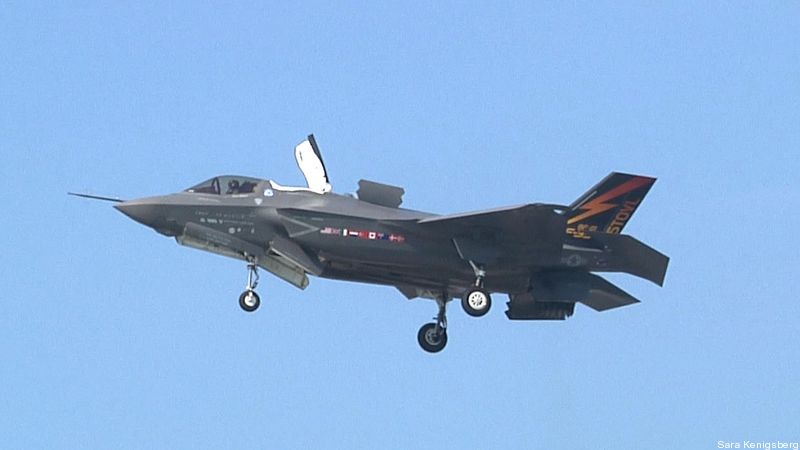F-35B Decision Data Ready Next Summer; First Look at Plane in Flight
Posted on

Washington: Sometimes events are, in and of themselves, news. So it was today when the Joint Strike Fighter program working with the Marines, flew the F-35B for the first time in front of a carefully selected portion of the defense press corps.
For more news and information on the swiftly-changing defense industry, please sign up for the Breaking Defense newsletter. You can also catch us on Twitter @BreakingDefense.
They flew us in V-22s down to Patuxent River, where the planes are being flight-tested, from the Pentagon. The chairman and CEO of Lockheed Martin, Bob Stevens, was there. The Marine Corps Commandant, Gen. James Amos, was there. The vice admiral in charge of the F-35 program, Dave Venlet, was there. The vice admiral in charge of Naval Air Systems Command David Architzel, was there.
Today’s trip was clearly an effort by both the Marines and the Joint Program Office, which Venlet heads, to demonstrate to the American public and to Congress that the F-35 is flying well, building up test data and that its price and schedule are under control — within the limits of a highly advanced technology program. For the Marines, it was more an effort to prove that the F-35B and the V-22 are worth the money — as are the Marines.
Gen. Amos claimed that today’s trip was not a “shaping” exercise and then proceeded to try and shape our views — all of it legitimate education and an admirable effort to reach beyond the Beltway and tell the American people his story. But it was still shaping. The press had a rare chance to press him on why the country should buy the Marines version of the plane. And Amos, the first pilot to serve as commandant, defended the program pretty convincingly.
“What we wanted today was just to get the truth out,” he said.
The country, Amos said, had a basic choice: field 11 or 22 carriers. Take away the F-35B and America would be left with half as many carriers because the Harrier jump jet is closing in on the end of its operational life. If it is retired and there aren’t any F-35Bs, then the Marines would be left with their smaller deck carriers and virtually nothing to put on them that could do what the Marines recently did in Libya. They led the way in striking Muammar Qaddafi, without a single big-deck Navy carrier in sight.
So, Amos said, the country and the senior Pentagon leadership need to decide whether building the Vertical Takeoff and Landing version of the F-35, especially in these parlous budgetary times, is worth it. “Is the juice worth the squeeze? We’ve got to have that discussion…” Amos said.
After Amos took questions, I got about 15 minutes with Venlet and Architzel. I pressed Venlet on when he thought the F-35B could come off the two-year probation which former Defense Secretary Robert Gates imposed on the program. He said they wouldn’t have enough flight-test and sea trial data until at least next summer when he would then make a recommendation. The VTOL plane is due to head for sea trials aboard the USS Wasp either in September-October (which is what the commandant said) or October-November, which is what someone I couldn’t see said at the event today.
Venlet also reiterated his now standard line that all the F-35B problems uncovered during recent testing have solutions. One of the reasons no decision can be made before next summer — at the earliest — is because those fixes must now undergo extensive testing. He will take that data and share it with the commandant “for his discussion with the secretary.”
And I asked Venlet the money question: who paid for today’s flight of the F-35B and all that surrounded it. “It is out of the JPOs budget, which is resourced by all three services.” The plane flew one of its more than 100 short vertical takeoffs and provided test data throughout the flight, he said: “So there is value for the dollars expended today.”
Adm. Architzel, clearly a bit ruffled by my questions, was more pointed: “This is not an event. We would not do this without capturing the data that comes from this.”
What were the impressions gathered from the event? Having witnessed tests of the F-35B’s engine, I wasn’t surprised by the incredible thrust it generates. But the stability it demonstrated during a sustained hover stunned me. I could picture myself sitting on the wing and fishing in the Pax River. And seeing an advanced fighter jet fly at 60 mph — slower than Cessna can fly — was pretty amazing. But all this is part of why the Marines want the plane. It can land or takeoff from a huge array of locations. And its flight envelope is enormous. Combine that with stealth and unparalleled ISR and cyber capabilities and you may just have one impressive weapon.
Subscribe to our newsletter
Promotions, new products and sales. Directly to your inbox.
